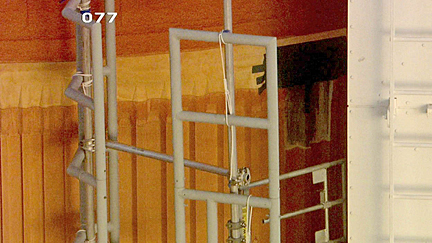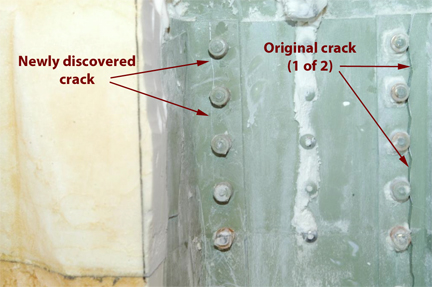Second cracked stringer found on Discovery's external tank (UPDATED)
Editor's note...
CBS News
KENNEDY SPACE CENTER, FL--Engineers removed additional foam insulation near a cracked structural support strip, or stringer, in the shuttle Discovery's external tank and found yet another crack in an adjacent stringer, NASA officials confirmed late Friday.
Discovery was grounded Nov. 5 by a gaseous hydrogen leak in a 7-inch vent line quick-disconnect fitting, delaying the flight until at least Nov. 30 when the next available launch window opens.
Engineers later discovered an area of cracked foam insulation on the external tank in a ribbed section that separates the liquid oxygen and hydrogen tanks. When the damaged foam was cut away, two 9-inch-long cracks were found in an underlying attachment plate holding a vertical support strip, or stringer, in place.
Engineers quickly developed a plan to repair the damage by installing a replacement section, bolting on a so-called doubler to provide additional strength and then spraying on fresh insulating foam.
But first, additional foam was removed from the area to make sure no other problems were present. And that's when engineers discovered a small crack in the stringer to the immediate left of the one already known to be damaged.
"During foam removal and inspection of adjacent stringers to the one with two nine-inch cracks, technicians today identified an approximately 3-inch crack on the left-hand adjacent stringer," NASA said on its shuttle web page. "This was not an unexpected result since the load was most likely transferred to the adjacent stringer when both sides of the original stringer cracked during tanking operations for Discovery’s scrubbed launch attempt on Nov. 5."
Engineers will use "structural math models" to characterize the forces acting on the stringers during launch to make sure repairs will be sufficient to provide the required margin of safety.
In the meantime, another team of engineers is finalizing plans for replacing the leaking hydrogen vent line fitting. They originally planned to install replacement hardware Friday, but managers have delayed the operation to early next week to collect additional data.
The goal is to measure and inspect additional ground umbilical carrier plate, or GUCP, components to make sure hardware is identified that will provide the best possible fit. The fitting that leaked apparently had an internal concentricity, or alignment problem that may have provided a leak path under cryogenic conditions.
NASA managers are considering a fueling test to make sure the replacement hardware remains leak-free when supercold propellants are pumped aboard. But given the foam repair work, managers have not yet settled on a target date for the test.
- Posted at 05:07 PM, 11/12/10: Second cracked stringer found on Discovery's external tank, sources say
- Updated at 08:40 PM, 11/12/10: Adding NASA statement; additional details
CBS News
KENNEDY SPACE CENTER, FL--Engineers removed additional foam insulation near a cracked structural support strip, or stringer, in the shuttle Discovery's external tank and found yet another crack in an adjacent stringer, NASA officials confirmed late Friday.
 |
| An enlarged area of foam removal near cracked structural stringers on the shuttle Discovery's external tank. (Photo: NASA) |
 |
| A closeup view of a newly discovered crack in the shuttle's external tank. (Photo: NASA) |
Engineers quickly developed a plan to repair the damage by installing a replacement section, bolting on a so-called doubler to provide additional strength and then spraying on fresh insulating foam.
But first, additional foam was removed from the area to make sure no other problems were present. And that's when engineers discovered a small crack in the stringer to the immediate left of the one already known to be damaged.
"During foam removal and inspection of adjacent stringers to the one with two nine-inch cracks, technicians today identified an approximately 3-inch crack on the left-hand adjacent stringer," NASA said on its shuttle web page. "This was not an unexpected result since the load was most likely transferred to the adjacent stringer when both sides of the original stringer cracked during tanking operations for Discovery’s scrubbed launch attempt on Nov. 5."
Engineers will use "structural math models" to characterize the forces acting on the stringers during launch to make sure repairs will be sufficient to provide the required margin of safety.
In the meantime, another team of engineers is finalizing plans for replacing the leaking hydrogen vent line fitting. They originally planned to install replacement hardware Friday, but managers have delayed the operation to early next week to collect additional data.
The goal is to measure and inspect additional ground umbilical carrier plate, or GUCP, components to make sure hardware is identified that will provide the best possible fit. The fitting that leaked apparently had an internal concentricity, or alignment problem that may have provided a leak path under cryogenic conditions.
NASA managers are considering a fueling test to make sure the replacement hardware remains leak-free when supercold propellants are pumped aboard. But given the foam repair work, managers have not yet settled on a target date for the test.